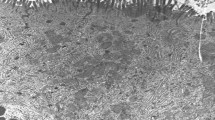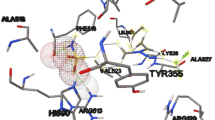Abstract
Purpose
The present study was conducted to elucidate the potential of selenium supplementation, if any, in affording chemoprevention by modulating the altered cancer markers and ultrastructural changes in dimethyl hydrazine (DMH)-induced colorectal carcinogenesis in rats.
Methods
The rats were segregated into four groups, viz., normal control, DMH treated, selenium treated, and DMH + selenium treated. Initiation and induction of colon carcinogenesis was achieved through weekly subcutaneous injections of DMH (30 mg/kg body weight) for both 10 and 20 weeks. Selenium was supplemented to rats at a dose level of 1 ppm in drinking water ad libitum for two different time durations of 10 and 20 weeks.
Results
The study observed a significant increase in the number of aberrant crypt foci (ACF) in colons of DMH-treated rats at both time intervals which were decreased significantly upon selenium supplementation. Also, a significant increase was seen in the enzyme activity of alkaline phosphatase (ALP), which, however, was moderated upon selenium administration to DMH-treated rats. Changes in the ultrastructural architecture of colonic cells were apparent following both the treatment schedules of DMH; however, the changes were prominent following 20 weeks of DMH treatment. The most obvious changes were seen in the form of altered nuclear shape and disruption of cellular integrity, which, upon selenium supplementation, were appreciably improved.
Conclusion
In conclusion, the study shows the chemopreventive abilities of selenium against DMH-induced colorectal carcinogenesis in rats.








Similar content being viewed by others
References
Ao P, Galas D, Hood L, Zhu X. Cancer as robust intrinsic state of endogenous molecular–cellular network shaped by evolution. Med Hypotheses. 2008;70(3):678–84.
Jemal A, Bray F, Melissa M. Global cancer statistics. CA Cancer J Clin. 2011;1(69):69–90.
Manju V, Nalini N. Chemopreventive efficacy of ginger, a naturally occurring anticarcinogen during the initiation, post-initiation stages of 1,2 dimethylhydrazine-induced colon cancer. Clin Chim Acta. 2005;358:60–7.
Devasena T, Rajasekaran KN, Gunasekaran G, et al. Anticarcinogenic effect of bis-1,7-(2-hydroxyphenyl)-hepta-1,6-diene-3,5-dione a curcumin analog on DMH-induced colon cancer model. Pharmacol Res. 2003;47(2):133–40.
Inamori Y, Misumi A, Murakami A, Akagi M. The histogenesis of DHM induced colonic carcinoma in rats. J Gastroenterol. 1987;22(1):7–17.
Vijayta D, Vaiphei K, Dhawan DK. Zinc mediated normalization of histoarchitecture and antioxidant status offers protection against initiation of experimental carcinogenesis. Mol Cell Biochem. 2007;304(1–2):101–8.
Dani V, Dhawan DK. Ultrastructural changes in rat colon following 1,2 dimethylhydrazine induced colon carcinogenesis: protection by zinc. Oncol Res. 2010;19(1):1–11.
Toth BL, Malick H, Shimizu H. Production of intestinal and other tumors by 1, 2-dimethylhydrazine dihydrochloride in mice. I. A light and transmission electron microscopic study of colonic neoplasms. Am J Pathol. 1976;84(1):69–86.
Margaret P, Rayman GF, Combs JR, David JW. Selenium and vitamin E supplementation for chemoprevention. JAMA. 2009;301(18):1876.
Ganther HE. Selenium metabolism, selenoproteins, and mechanisms of cancer prevention: complexities with thioredoxin reductase. Carcinogenesis. 1999;20:1657–66.
Ghadi FE, Ghara AR, Bhattacharya S, Dhawan DK. Selenium as a chemopreventive agent in experimentally induced colon carcinogenesis. World J Gastrointest Oncol. 2009;1(1):74–81.
Soler AP, Miller RD, Laughlin KV, Carp NZ, Klurfeld DM, Mullin JM. Increased tight junctional permeability is associated with the development of colon cancer. Carcinogenesis. 1999;20:1425–31.
Goel A, Dani V, Dhawan DK. Protective effects of zinc on lipid peroxidation, antioxidant enzymes and hepatic histoarchitecture in chlorpyrifos-induced toxicity. Chem Biol Interact. 2005;156:131–40.
Bergmyerer Bergmeyer HU. Phophatase (phosohomonoestrals) determination in serum with p-nitrophenyl phosphatase. In: Bergmeyer HV, editor. Methods of enzymatic analysis. New York: Academic; 1963. p. 283.
Kinzler KW, Nilbert MC, Vogelstein B. Identification of gene located at chromosome 5q21 that is mutated in colorectal cancer. Science. 1991;251:1366–70.
Gadre SG, Kale KU, Hedge R, Raste AS. Comparative study of alkaline phosphatase and prostate specific antigen in prostate cancer. Indian J Med Sci. 2000;54(4):136–9.
Saif MW, Alexander D, Wicox CM. Serum alkaline phosphatase level as a prognostic tool in colorectal cancer: a study of 105 patients. J Appl Res. 2005;5(1):88–95.
Yamaguchi M, Yamaguchi R. Action of zinc on bone metabolism in rats: increase in alkaline phosphates activity and DNA content. Biochem Pharmacol. 1996;35(5):773–7.
Park EJ, Jeon CH, Ko G, Kim J, Sohn DH. Protective effect of curcumin in rat liver injury induced by carbon tetrachloride. J Pharm Pharmacol. 2000;52(4):437–40.
Takatsugu O, Rey-Chen P, Yingming L, Jer-Tsong H. The role of cancer adhesion molecule in cancer progression and its application in cancer therapy. Acta Biochem Pol. 2004;51:445–57.
Dani V, Dhawan DK. Membrane fluidity and surface changes during initiation of 1,2 dimethylhydrazine induced colon carcinogenesis: protection by selenium. Oncol Res. 2009;18:17–23.
Conflict of interest
None.
Author information
Authors and Affiliations
Corresponding author
Rights and permissions
About this article
Cite this article
Ghadi, F.E., Malhotra, A., Ghara, A.R. et al. Chemopreventive Effects of Selenium on Cancer Marker Indices and Ultrastructural Changes During 1,2 Dimethylhydrazine-Induced Colon Carcinogenesis in Rats. J Gastrointest Canc 44, 54–59 (2013). https://doi.org/10.1007/s12029-012-9451-9
Published:
Issue Date:
DOI: https://doi.org/10.1007/s12029-012-9451-9




